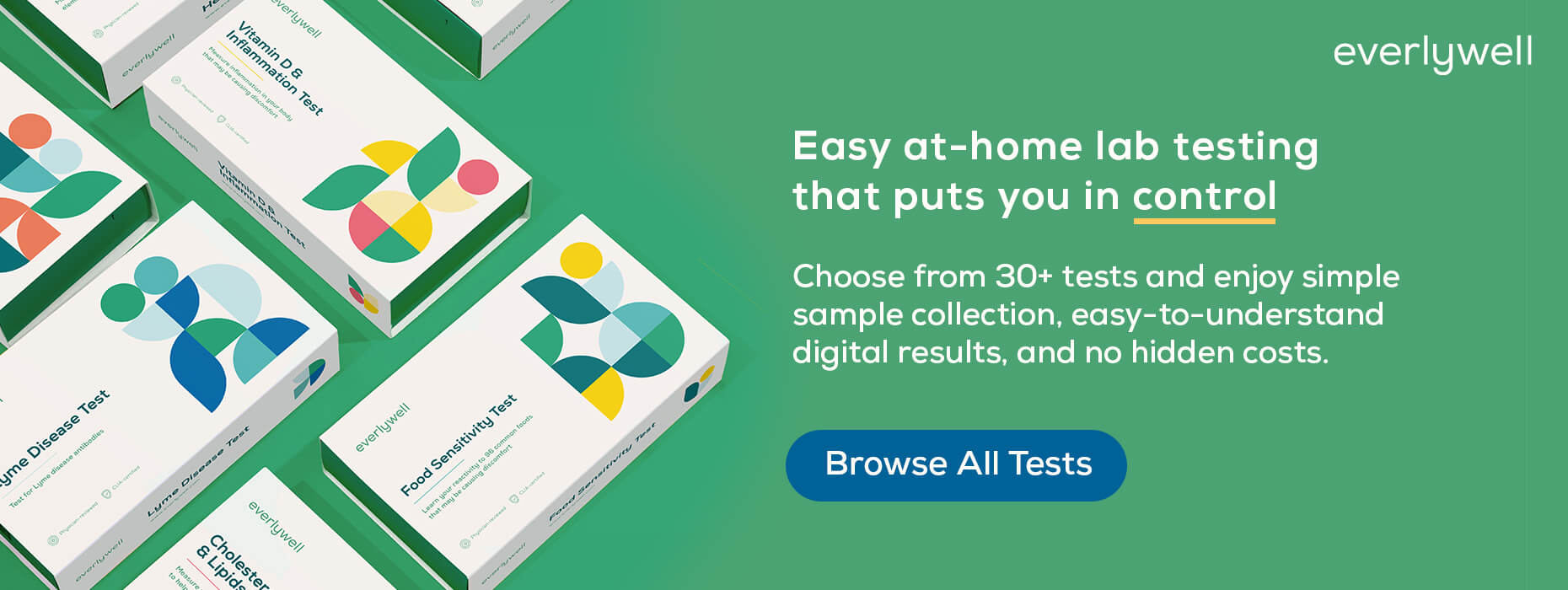
How long can HPV be dormant?
Medically reviewed on February 22, 2022 by Jordan Stachel, M.S., RDN, CPT. To give you technically accurate, evidence-based information, content published on the Everlywell blog is reviewed by credentialed professionals with expertise in medical and bioscience fields.
Human papillomavirus (HPV) is the most common sexually transmitted infection (STI) [1]. Roughly 80 percent of adults will contract it at some point during their lifetime [2].
While many people catch HPV, very few people realize they have it. That’s because HPV can remain dormant in the body without causing any noticeable symptoms.
If you’re wondering “How long can HPV be dormant?” you’re in the right place. The answer is a broad one, however. HPV carriers may live asymptomatically with the infection for as little as a couple of months or their entire life after becoming sexually active. Although this is the case, Everlywell has an HPV test kit which allows you to easily detect HPV from your own home.
To help you learn more about this ubiquitous disease, we’ll debunk some popular myths about HPV dormancy and discuss a few ways to prevent it from spreading.
7 HPV Dormancy Myths
To start, let’s examine the truth behind the following seven HPV dormancy myths:
Myth #1: HPV has a set dormancy period
While HPV can remain dormant for a long time, the maximum duration of its dormancy period is largely unknown. It seems to vary from person to person.
Some people clear their HPV infections within a few months, while others can have dormant HPV for decades—possibly the rest of their lives.
Myth #2: Once you get HPV, it never goes away
While HPV can remain dormant in the body for a long time, studies show that most people clear the virus within one to two years [3].
Just look at one study’s findings on HPV infection clearance time in college-aged women [4]:
- 70% of women cleared their HPV infection within one year
- 91% of women cleared their HPV infection within two years
- The median HPV infection duration was eight months
Myth #3: HPV infections always produce symptoms
Quite the opposite—HPV infections rarely cause symptoms. Most people clear their infection before they ever realize they have it.
The chances of experiencing a symptom from an HPV infection are influenced by the:
- Immune system – When you contract HPV, the immune system is responsible for fighting it off. Having a strong, healthy immune system can help the body clear the infection faster.
If the immune system is weak due to a poor diet, stress, HIV, or other immune-suppressing conditions, you may be more likely to experience symptoms from an HPV infection.
- HPV strain – There are over 100 different strains of HPV [5]. Most of these strains never result in symptoms and don’t require treatment.
However, some strains of HPV are considered high-risk. For example, HPV 16 and 18 can lead to various types of cancer. Studies show that strains 6 and 11 can also cause genital warts [6].
Even if the immune system fights off a low-risk strain of HPV quickly and no symptoms are noticed, you can still transmit the virus to others. That’s why getting vaccinated against HPV plays such a crucial role in its prevention.
Myth #4: You can’t get reinfected with HPV once you’ve cleared the infection
Since there are so many different strains of HPV, you may clear one infection and catch another strain in the future. Reactivation of symptoms from a previous HPV infection can also occur if the immune system hasn’t completely cleared the virus yet.
Myth #5: Getting a positive HPV test result during a long-term relationship indicates cheating
Since HPV is usually symptomless, most people only find out they have it from the following:
- Positive HPV test
- Abnormal pap smear result
- Outbreak of genital warts
If you’ve been in a monogamous relationship for a long time, receiving an STI diagnosis of any kind can be distressing. You may wonder if your partner passed this sexually transmitted disease to you from a past sexual partner. While possible, this isn’t necessarily the case with HPV.
HPV may have been contracted a long time ago. The infection could have been lying dormant for a long time. Furthermore, it can take years for an HPV infection to cause abnormalities in the cervical cells that are detectable during a pap smear. Due to the nature of HPV dormancy, having a sudden HPV symptom or symptoms arise doesn’t always mean infection took place recently.
Myth #6: Condoms offer complete protection against HPV
Condoms can certainly reduce the risk of contracting HPV, but they don’t offer complete protection. That’s because HPV is largely transmitted through skin-to-skin contact [7]. Any skin-to-skin contact in the genital area can transmit the virus, even if it occurs outside of intercourse. Since condoms only cover a portion of genital skin, they may still allow HPV transmission to take place.
Myth #7: HPV only affects women
Due to the prevalence of cervical cancer screening, women may be more aware of the risk of HPV than men. While men are less likely to experience symptoms from HPV, they can still contract the virus, spread it to others, and potentially develop genital warts or cancer from it.
Some types of cancer that have been linked to HPV are [8]:
- Cervical cancer
- Anal cancer
- Penile cancer
- Vaginal cancer
- Vulvar cancer
- Oropharyngeal cancer
Since HPV can cause cancer and genital warts in both sexes, it’s recommended that every man and woman receive the HPV vaccine before any sexual activity.
HPV Risk Factors
Now that you know the truth behind these HPV myths, you may be wondering what the risk factors are for contracting the virus.
Some of the most notable risk factors are [9]:
- Being sexually active
- Engaging in unprotected sex
- Having sex with several different partners
- Having a weakened immune system due to HIV or another condition
- Not getting vaccinated against HPV at a young age
Since many of these risk factors are quite common, it paints a clearer picture as to why HPV is such a widespread STI.
How to Reduce the Spread of HPV
Even though HPV is harmless in most cases, it’s still important to do what you can to minimize the spread of the virus.
Here are the best ways to avoid contracting HPV.
Get vaccinated against HPV
The HPV vaccine protects against the strains of HPV that are most likely to cause genital warts and cancer.
The CDC recommends that children get the HPV vaccine around age 11 before they become sexually active [10]. If you’re an adult who hasn’t yet been vaccinated against HPV, you can still do so up until the age of 45. The vaccine is approved for males and females.
Getting the HPV vaccine is the best way to avoid spreading the virus and developing serious symptoms from a high-risk strain.
Get HPV testing before having sex with new partners
It’s always a good idea to know your and your partner’s STI status. Before having sex with someone new, consider getting HPV testing and other STI testing done to ensure you don’t pass anything on to each other.
Use barriers during sex every time
Condoms and dental dams can offer some protection against HPV, as well as many other STIs.
Don’t have sex if you have a genital wart
A genital wart may indicate an active HPV infection. If you or your partner experience an outbreak of warts in the genital area, it’s a good idea to refrain from having sex until they’ve cleared up.
Keep the immune system strong
There’s a high chance that you’ll encounter HPV at some point in life. In addition to getting vaccinated, supporting a healthy immune system can help to clear an HPV infection quickly.
Here are a few immune-boosting habits you can add to your lifestyle [11]:
- Eat a healthy diet that’s low in saturated fat and sugar
- Exercise regularly
- Avoid excessive alcohol consumption
- Don’t smoke
- Find ways to reduce stress levels
Get screened for cervical cancer
A woman can prevent HPV-related cervical cancer by having regular pap smears and HPV tests.
The current cervical cancer screening recommendations are as follows [12]:
- Pap smears – Women who are 21 to 29 years old should have a pap smear every three years. Women who are 30 to 65 years old can reduce their pap smear frequency to every five years if they have an HPV test done at the same time.
- HPV tests – Women should have an HPV test done every five years, starting at age 30 and continuing until the age of 65.
If you’re wondering about the differences between HPV tests and pap smears, both are great for detecting cervical cancer. These two screening tools can reveal any cervical cell abnormalities or high-risk HPV infections before they lead to cervical cancer. If cervical cancer develops, these tests can help someone receive an early diagnosis with a more optimistic prognosis.
Everlywell: HPV Home Test Kit For Women
HPV is a common STI. Luckily, there are many ways to protect yourself from it. In addition to getting the HPV vaccine, you can monitor your cervical health with an at-home HPV test.
Here at Everlywell, our at-home High-Risk HPV Test is non-invasive and easy to use. You can administer it from the comfort of your own home. After taking the test, all you have to do is send it off to one of our CLIA-certified labs. You’ll receive your results shortly after.
Your test results will help you determine if you have any of the 14 high-risk strains of HPV, including the ones known to cause cervical cancer. Plus, you can discuss your results with one of our independent physicians at no extra charge.
Related content
Can you have HPV without symptoms?
How many types of HPV are there?
HPV testing guidelines: here’s what you need to know
References
1. STD Facts - Human papillomavirus (HPV). Centers for Disease Control and Prevention. URL. Accessed February 22, 2022.
2. HPV (Human Papillomavirus). National Foundation for Infectious Diseases. URL. Accessed February 22, 2022.
3. Brown DR, Weaver B. Human Papillomavirus in Older Women: New Infection or Reactivation? Journal of Infectious Diseases. 2012;207(2):211-212.
4. Braaten KP, Laufer MR. Human Papillomavirus (HPV), HPV-Related Disease, and the HPV Vaccine. Rev Obstet Gynecol. 2008;1(1):2-10.
5. HPV (human papillomavirus). U.S. Food and Drug Administration. URL. Accessed February 22, 2022.
6. Garnock-Jones KP, Giuliano AR. Quadrivalent Human Papillomavirus (HPV) Types 6, 11, 16, 18 Vaccine. Drugs. 2011;71(5):591-602.
7. HPV infection - Symptoms and causes. Mayo Clinic. URL. Accessed February 22, 2022.
8. Is HPV linked to cancers in men? Mayo Clinic. URL. Accessed February 22, 2022.
9. HPV infection - Symptoms and causes. Mayo Clinic. URL. Accessed February 22, 2022.
10. STD Facts - Human papillomavirus (HPV). Centers for Disease Control and Prevention. URL. Accessed February 22, 2022.
11. How to boost your immune system - Harvard Health. Harvard Health. URL. Accessed February 22, 2022.
12. What Should I Know About Cervical Cancer Screening? Centers for Disease Control and Prevention. URL. Accessed February 22, 2022.
